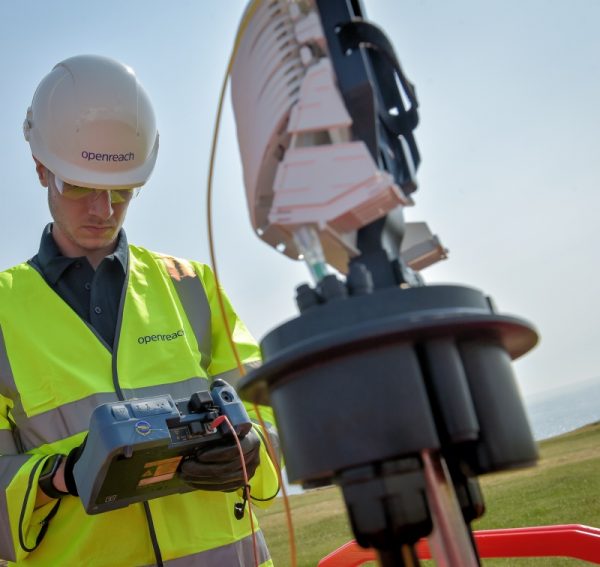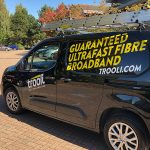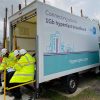Openreach Still Coy on Plan to Fix 330Mbps Capped UK FTTP Lines

Openreach has informed ISPreview.co.uk that they recognise the plight of the less than 50,000 premises that are still stuck on older ECI based Fibre-to-the-Premises (FTTP) broadband lines, which limits such homes to a top download speed of 330Mbps. But there’s still no certainty about when this will be resolved.
The operator’s new full fibre network currently covers over 7.6 million UK premises, and they’re aiming to reach 25 million by December 2025. The primary rollout for this started in 2018, but it’s often easy to forget that Openreach had already covered 500,000 premises in the decade prior to that date (between 2008 and 2018), including a big chunk around Cornwall.
The modern deployment supports speeds of up to 1Gbps or faster, but a small chunk of those built pre-2018 were done using much older technology from Israel-based telecommunications firm ECI. Back in 2019 Openreach informed us (here) that this accounted for “less than 50,000 premises” on their full fibre network, which is a tiny proportion of their build, unless you happen to be one of those affected.
Advertisement
At the time we said that being capped to a top speed of 330Mbps wasn’t the end of the world, but that it would become more of an issue as competition increased. Since then a mass of new operators, all deploying 1Gbps to 10Gbps capable full fibre networks, have emerged and some of those may be starting to build across a few of the aforementioned ECI areas, which leaves Openreach at a disadvantage.
The challenge is that upgrading the ECI based Optical Line Termination (OLT) and Optical Network Terminals (ONT / ONU) kit to use modern equipment from ADTRAN or Nokia would not be an easy task and could risk some downtime for end-users. But there are different ways of doing this, and we don’t yet know what Openreach’s approach might be. In any case, back in 2019, they didn’t have any plans for tackling this.
Some of those affected recently nudged us to get an update on this situation from Openreach. A spokesperson for the operator said they “accept that some of our high end services are not available to these customers” and revealed that, “at some point“, they will “change out the equipment in the exchange“. But as for any specifics or timescales, none were forthcoming.
Openreach added that they continue to have technical support arrangements in place, thus there are no impending service issues for ECI customers (i.e. if your ECI ONT in the home or office fails then they’ll still replace / fix that via your ISP).
Advertisement
Mark is a professional technology writer, IT consultant and computer engineer from Dorset (England), he also founded ISPreview in 1999 and enjoys analysing the latest telecoms and broadband developments. Find me on X (Twitter), Mastodon, Facebook, BlueSky, Threads.net and Linkedin.
« Virgin Media O2 UK Fix Midnight Broadband Connectivity Fault























































Truthfully in Openreach terms there are not many “different ways of doing it”, they won’t be allowed, or able to take service out for a day for each splitter and enter every home and swap the ONT, so they have two options really;
1) Sit it out and wait for XGS-pon (and 2.5Gbe end user services?) to be rolled out, perhaps making ECI areas a priority when this becomes a thing Openreach do in $x years time.
2) Provision a parallel nokia Pon for each ECI pon (it’s own fibre back to the exchange and new 32 way splitter) and then make 1Gb orderable and develop the systems users over whenever there is a upgrade/new provide.
Option 2 is so expensive, and difficult from a systems perspective that given there are so few premises affected that I think the “do nothing for a while” will be more likely. Maybe there is room for a middle ground of XGS-Pon trial that happens to cover ECI areas :).
“Provision a parallel nokia Pon for each ECI pon (it’s own fibre back to the exchange and new 32 way splitter) ”
That’s wholely unnecessary. Everything between the ONT and OLT is passive. Splitters don’t need changed.
They simply need to setup a Nokia/Adtran OLT and configure it for the ECI users.
Swap the fibre at the ODF moving the ECI users to the new OLT.
The existing ECI ONT should be able to continue to be used as they do now with Nokia ONT’s being the default on Huawei OLT’s.
The issue is this all may need coordinated timing with every ISP on each PON to ensure everything is routed correctly after the change.
Worst case scenario is the ONT needs swapped out. They won’t allow end users to do this so a few engineers would be required to visit every live property on the PON during the changeover window.
There’s no reason that should be necessary. If the current Huawei/Nokia OLT’s can be configured to work with 3rd party ONT’s then there’s nothing special about the ECI ONT meaning it can’t be used.
John, I’ve never met you but I’m going to say you’re Scottish. Am I corrrect?
Why, because “needs changed”?
Geordies and Irish speak like this too 🙂
No profiles for ECI ONUs on other vendors’ OLTs else they’d have done it by now. Extensive use of Huawei OLTs in areas that were originally ECI for years – BDUK didn’t install any ECI.
The cleanest way to do it IMHO is to provide XGSPON, make 550/1000 available, and replace ONUs as and when customers order those faster services.
It’s true that it may be theoretically possible to build a eci profile for Huawei and Nokia OLTs and do all the interop testing and validation needed for the same.. however that assumes two things:
The cost to openreach of doing that, plus the new OLT is less than E.g a xgspon on the same pon ready to be used by those who upgrade (no way).
That they will be able to take a PON out for say an hour to switch it to the new OLT, and with confidence that no problems will be caused whatsoever.
The interoperability requires vendor buy-in, it’s not something Openreach will configure themselves.
Openreach aren’t going to pay Huawei / Nokia the required cash and go through the contract negotiations to have their OLTs support ECI ONUs and ECI aren’t likely to be enthusiastic about Openreach rendering their OLTs obsolete and no longer paying licence and support subscriptions.
The Huawei / Nokia interoperability they had no real choice over and Huawei would be aware.
Don’t you think if it were as easy as some configuration by Openreach they’d have done it already?
Didn’t mention XGSPON release especially for ECI areas but at some point Openreach are going to have to overlay GPON.
XGSPON is going to sit very lightly used for ages anyway. It’ll be running alongside GPON as it does elsewhere in the world and that was the entire point of putting it on different wavelengths.
New installs and upgrades on XGSPON, customers on GPON not making changes stay there.
That was more comment towards John rather than you -.
Appreciate you were agreeing with me that XGSPON makes far more sense than migrating GPON.
This affects around 0.6% of the total Openreach FTTP estate and as the national build progresses will move to something in the order of less than 0.2% of the total.
So it’s hardly a huge, burning issue and of the subscribers wanting > 330 Mbps would be less than 20% of those.
So it’s kind of understandable where Openreach’s ultimate priorities are with this.
As said, the simplest path off ECI is to build an XGS-PON enabled headend and run this contemporaneously with GPON over the same glass. Then migrate customers as needed. Separate PON or service interruption avoided. This is the intended migration path with mixed mode operation of GPON and XGS-PON combined.
“Extensive use of Huawei OLTs in areas that were originally ECI for years – BDUK didn’t install any ECI.”
Yes, they did.
The very 1st BDUK contracts, including some FTTP, were on ECI infrastructure.
Shortly after BDUK went exclusively Huawei and used no more ECI.
The amount of ECI BDUK is absolutely tiny, but that’s more than none.
Okay. BDUK installed a small amount of ECI.
Happy to admit I’m wrong, always, as everyone should be.
Perhaps they can swap it over once everyone has left to the first altnet that shows up.
Made me LOL Mike.
I love your thinking but you’re also hilariously wrong if you think that’s how it goes. The altnets are more at risk than the Openreach side – and not everyone cares about having gig over 330 meg…
Only 330, omg my heart bleeds
With the greatest respect as someone who only gets a 8meg FTTC connection and has been quoted £14k for the 700m, already ducted run, for a FTTP_OD connection, I would be more than happy with 330meg…..♂️
Nah for 14K they have to do civil works too – after all fibre is £5.55 a meter right now according to quoters and 455 of line was £2525.25 when I had it. so 700M should only be about 4K. They have more to do for the extra 10K
‘Only’ 330Mbps! If I had those speeds I’d be deliriously happy! Why are BT prioritising this above providing a half decent broadband service to those who us are still on copper lines? Our download maxes out at around 5Mbps and upload is 0.7Mbps, although sometimes it drops so low it fails to register anything on BT’s speed checker…
They aren’t prioritising it. That’s literally the entire point of the article that it’s not a priority and there’s no public timescale for sorting it.
The two work flows either way are nothing to do with each other so no prioritising one over the other.
The people in those areas should try and attract the attention of the altnets as its a prime area for them to move in to and bring their own technology.
Though not as good as areas with nothing other than FTTC.
“as its a prime area for them to move in to and bring their own technology.”
Its really not, most of the ECI areas seem to be in rural areas where the small number of customers made FTTP cheaper than installing a FTTC cabinet.
Building over more built up FTTC areas would make more sense for the provider.
I will be more than happy to have 160/160 FTTP that be good enough for me!
Oh max…
You literally upload nothing and have said so yourself.
You use your connection mainly to stream Netflix.
You’ve conceded elsewhere that 40/10 on FTTC is sufficient for your needs.
Instead of ordering that though you spent years on 80/20.
Then you wasted a small fortune buying a G.Fast package you didn’t need.
Now you have apparently downgraded to the 40/10 package you should have took in the 1st place.
So why on Earth do you now need 160Mbps upload?!?
That’s 3 posts on this article alone you have criticized Openreach’s download:upload ratio when the reality is that ratio suits the majority of customers current usage.
Anything over 100 meg would be fine right now, to be honest i’d like better upload..
The reality is that people are limited to lower than 330Mbps due to the products ISPs are offering. I had a quick look at the big providers (Sky, BT, TalkTalk) and none of them offer anything between 160Mbps and 550Mbps.
Yeah. The reason is just that the wholesale products 220 and 330 don’t represent good value, for example 330 is about a pound a month less than 550 and does not benifit from one of the Openreach promotions so realistically 550 is basically the same price as 330 at wholesale. Vodafone and Shell do sell those products anyway though.
Anything lower than 160/160 on FTTP will be lots benefit to more peoples because the cost will be much cheaper than FTTP 330/50, 550/75 and 1000/115
Many of us would be pleased to get near to 300mb,rather than poultry 30 if lucky, so sorry but little sympathy for those poor souls who are missing out on 500+……
330 download is plenty enough tbh. The is and always will be upload speeds because the UK companies will not do what others countries do… provide a real synchronous service where download and upload are the same speed.
Just look at Virgins pitiful gigabit offering, they went for 1,100+ download so they could say they have fasted internet but the upload is no better than 2005 days. Their upload is on that gigabit service is artificially capped to a tiny 36mbps and quite frankly that is disgusting.
Speak to people in the EU, US and Asia who say they gigabit consumer plans are gigabit up and down.
This site does not do anywhere near enough to challenge our ISPs on this travesty, those companies should be harassed and embarrassed into providing proper upload speeds.
The upload on VM’s Gig1 is 52 not 36 and is comparable to most other cable companies.
Speak to people in the EU, US and Asia they’ll confirm that their uploads are similar and in many cases lower over cable. They need full fibre that isn’t RFoG to offer higher.
That you think this is some harsh arbitrary limit you’re mistaken. Cable networks are very asymmetric and the products offered reflect this.
VM’s cable networks have about 40 MHz of usable upstream bandwidth, each customer locked to 25.6 MHz of spectrum, shared between perhaps 200 customers.
They’ve over 400 MHz of higher quality downstream spectrum that runs at between 33.3% and 100% higher efficiency making that spectrum worth the equivalent of 600 MHz of upstream spectrum.
Given those numbers you can see where the ratio comes from.
VM are addressing this with more efficient use of upstream spectrum and are replacing the coax alongside upgrading the RFoG full fibre to symmetrical XGSPON.
If you want to complain about asymmetry start with Openreach and their full fibre. The ratio of their capacity is 2:1 downstream to upstream but they sell slightly below 10:1 to residential customers and 5:1 to businesses, and do so for purely commercial reasons, not technical as with VM.
VM and Openreach are very poor overall for upload speed. Come on it 21st century! I would love to have FTTC 80/80 then later upgraded to FTTP 160/160.
Why? You don’t upload anything (that’s based on what YOU have repeatedly told us).
You’re on benefits and we’re currently in the middle of a cost of living crisis with energy bills having gone up 50%, due to go up another 50% and inflation running at a whopping 10%.
Why on Earth would you want/need to spend more for a symmetrical connection you don’t actually need.
@ John Anything lower than 160/160 on FTTP will be lots benefit to more peoples because the cost will be much cheaper than FTTP 330/50, 550/75 and 1000/115
the FTTP 160/160 will be lots cheaper maybe @ £28 per month
The comment “They need full fibre that isn’t RFoG to offer higher.” with regard to Virgin media isn’t entirely true.
VM COULD increase upload speed when ready by reducing noise in their HFC network, re-segmenting over utilised cabinets along with some spectrum management and changing the QAM level north of QAM64 once the noise issue is resolved. They could get 115mbps realistically and possible 200mbps on upload.
I’d expect to see this next on VM before the infrastructure is upgraded to full fibre by 2028 (as per VM’s own announcement).
True, I oversimplified that part. They could get to 100 with DoCSIS 3.1 and higher with node splits and noise busting, however more than 100 seems unlikely given the investment required in a legacy network.
In fact higher uploads are a work in progress with 3.1 now on the production network, albeit in pilot.
I really should’ve remembered that. My bad.
Does OpenReach still have any plans to install any from of fibre to exchanges that are still on ADSL copper? All we have available is Virgin media, and would rather there was more choice than paying £20-27 a month (for the first 18 months) for 50mbps. If they still think it’s not viable to put fibre for an exchange serving over 3,100 properties, at least six public houses, one large secondary with over 1,300 pupils (there may actually be another new secondary school built on a new housing estate that may be using this exchange as I’m not aware of a new exchange being built, and our exchange is the nearest to this still growing new estate), a small industrial estate and numerous shops, cafe’s and takeaway businesses. I can’t remember the exact percentage BT say of UK premises now having at least FTTC, but pretty sure it’s in the 90’s, but no matter what development’s of broadband there’s been over the decades, 8mbps to 24mps (upto), we always manage to end up being that very small percentage that doesn’t have the latest developments. And I’ve been checking to see rollout dates since the very first 40mbps (which has now dropped to around 35 by most ISP’s) for at least the last six years, and it still says ‘Sorry your exchange is not currently on our plans). It would t be so bad, if the original speeds of 20mbps on a good day we’re still achievable and more than 1mbps upload. But for the last eight years or so upload will not go above 0.87 and Download, the most I’ve had in the last four years or more is 14mbps, and this is despite living on the same
Pretty much straight all the way road, 900 metres away from the exchange. I hate BT with a passion, they mainly are still only interested in upgrading larger areas that already had the basic fibre, to the best FTTP. But then get paranoid that ppl will complain about rural areas being left out so pick a very small handful of exchanges that are quite remote as a token gesture to upgrade to try and make out they aren’t excluding rural communities, but what about the larger semi rural areas, one minute my area is classed as just another village where everyone knows everyone, then when people actually visit the village, they realise it’s not
Some small parish, therefore we won’t class it as rural. Can’t bloody win. Despite Virgin Media’s high prices, we were one of the first areas after Southampton, Reading and the other five or more big cities in the first phase of the upgrades. We even beat cities like Bristol and Nottingham to get the 1 gig upgrade. If Virgin could
Match the cheaper ISP’s like talk talk, Plusnet etc who use BT’s infrastructure, they could easily double their customer base as a minimum.